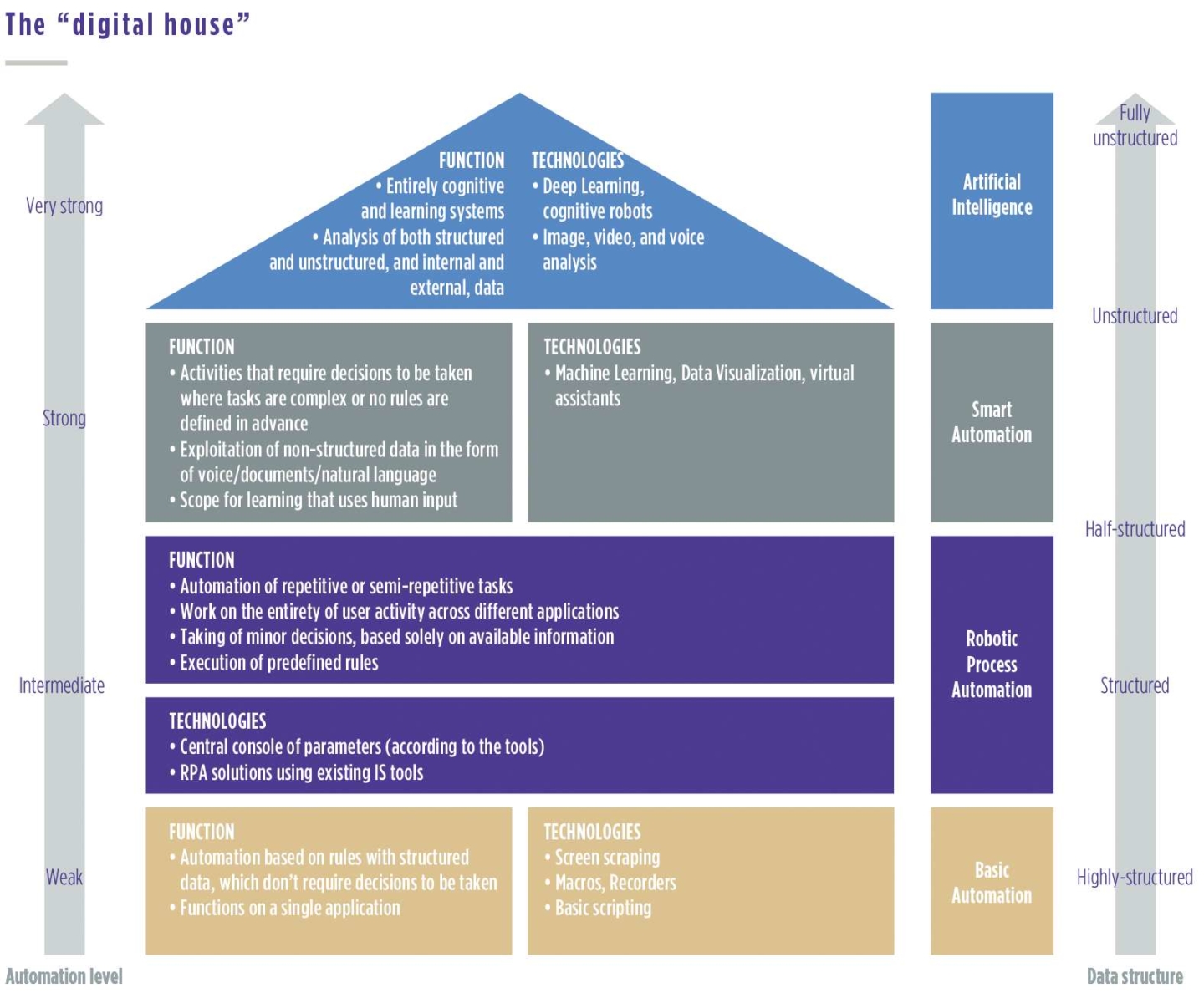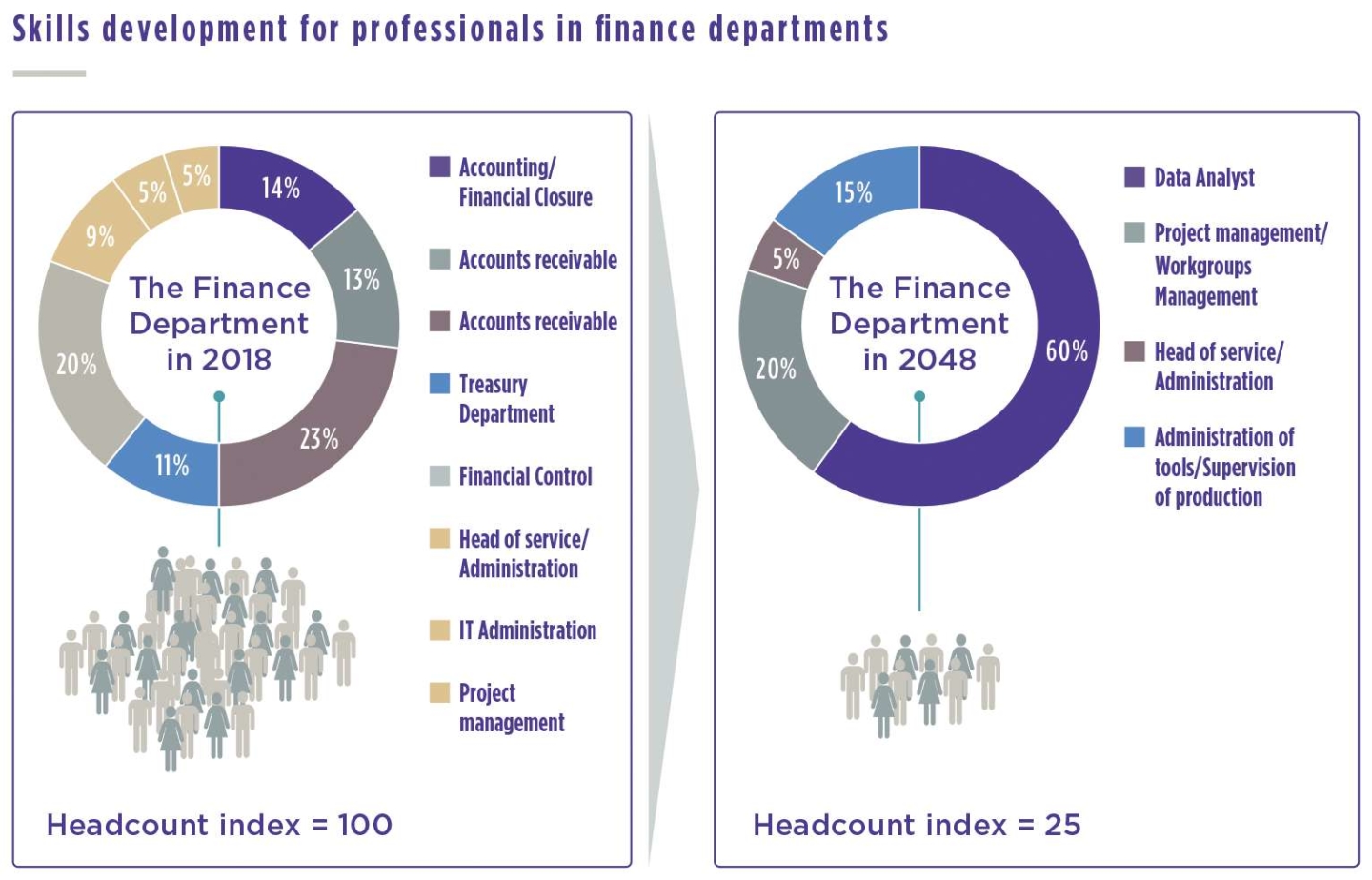Imagine a virtual employee, available 24 hours a day, 7 days a week, who carries out day-to-day transactions within a finance department… In fact, there’s no need to imagine it anymore—such employees already exist. But, this only apply to very “standard” operations; many activities these technologies are yet to master.
Now, imagine that this virtual employee can handle the most complex day-to-day transactions and operations, those that involve exceptions to operating rules… this is still an imaginary scenario—but not for long.
What are the technological developments in finance functions?
The needs of financial and accounting players are changing. Why do these players still have to make do with traditional “excellence” with its multiplicity of manual, repetitive entries, first-level controls and other ? The products on the market today offer “user friendly” features and interfaces, as well as interconnected databases, tools that other highly customer-oriented businesses have adopted already.
So why do finance functions seem to lag behind in the use of innovative technologies?
Finance functions are truly starting to embrace the shift toward the complete automation of their processes—putting in place tools that are ever faster, more flexible, more precise, more mobile, and more secure.
- Faster… Automated interfaces, dematerialization, RPA (Robotic Process Automation), and machine learning, already facilitate the processing of repetitive, manual, and time-consuming tasks, based on non-judgmental rules. It’s becoming easy to automate these activities—and so replicate daily “office” tasks.
- More flexible… The cloud offers an interesting margin of maneuver in terms of the administration of information systems and maintenance. There’s no need to manage servers and complex infrastructure—having the resources to code is all that’s needed. This facilitates the integration of new features, as well as reducing costs. In terms of , need in finance functions is for qualitative information to be fed back and shared—so that activity reports and results can be understood. Analyzing the activity becomes as important as the numbers themselves. The collaborative asset meets this need perfectly.
- More precise… Finance departments have quickly understood the importance of Big Data in providing more comprehensive reports. But its potential for these departments lies, in particular, in its predictive possibilities. EPM tools must make it easy to integrate new data in order to anticipate market changes and measure their impact on strategic development—as well as on their organizations.
- More mobile… The increasing use of smartphones and tablets by administrative and financial managers highlights their interest, not only in digital access to information, but also in optimizing back-office process-validation steps and management reporting.
- More secure… Attacks on computer networks have become a major concern for finance departments. They can jeopardize the processing of accounts and, in particular, open the door to fraud. The latest generation of cloud-based financial information systems have managed to reassure finance departments in this area by meeting both internal-control requirements and those of the GDPR (The General Data Protection Regulation).
Today, these technologies have been largely integrated within finance departments. Finance functions are now facing a new generation of technologies. And the most advanced departments are starting to incorporate the innovations offered by robotics, Artificial Intelligence and Big Data
Robotics
Artificial Intelligence
Big Data
RPA—is it really Accounting 2.0?
RPA appears to be the perfect tool for repetitive, manual, time-consuming tasks that are based on non-judgmental rules. It becomes easy to automate these tasks by replicating “desktop” actions.
RPA functions as a virtual operator managed by operational teams, or another robot that acts as the task scheduler. It enables tasks and transactions to be performed on existing systems (including the most widely-used ERPs on the market). The robots are integrated with existing software without disrupting the organization’s IS environment. It searches, processes, and analyzes the data on the various ISs.
In a supervised learning mode, the RPA collects, sorts, consolidates, and reworks the data—using a well-defined routine. In addition, the technical barriers are very low: RPA does not require programming capabilities.
By simulating user activities on existing applications, it allows actions to be modeled using scripts, recorders, and drag & drop, with little or no code development required. The market-leading tools offer almost 500 features (click, download, capture, input, controls between two documents, the writing and sending of emails, the reading of specific types of emails, copying, pasting, backup, and more). Bot libraries, shared by communities, are already available for existing processes and tools.
The benefits of productivity and time gains are easy to envisage, with robots that will be able to perform non-value added tasks that take up employee time.

Using RPA can enable companies to perform business processes five to ten times faster, which, in theory, means:
- Saved time: reduced production time for financial processes by eradicating manual data entry on multiple non-integrated information systems, reducing excel-based and copy/paste operations
- Better information quality: by making available reliable, accurate and visually-informative reports, through their integration into existing business tools like Excel, SAP, Oracle, and Citrix
- Enlargement of skillsets: through a focus on value-added activities that enable better assessment of the organization’s performance
Initiatives that are preparing the ground for AI
Next-generation digital programs aren’t legion within finance departments. Less than 16% of the sample in our CFO Digital barometer —an analysis of high-level trends aimed at finance directors—is engaged in this type of project.
Until recently, such technologies weren’t considered mature. But today, we’re witnessing the first wave of robotization of support functions—and finance functions are at the top of the list.
Nevertheless, RPA remains a tactical and temporary solution in the transformation of the support functions and their ISs. It represents the step before better IS interconnection and smarter learning.
Poor qualification, bad choices of processes, the replication of use cases not tailored to their environments, POCs (Proofs of Concept) that are marginal, undefined criteria for success, changes in skillsets, and social and HR impacts, are all effects associated with RPA programs—issues that are leading to disappointment.
While these programs claim the ability to automate accounting and finance functions, they still need to be tailored, designed, and integrated into a group’s overall strategy; and, above all, their implementation has to be strongly managed and supported. It’s only when these programs have been perfected, and are in widespread use, that they will form the foundation of a new “digital house” that will embrace machine learning, smart automation, and—ultimately—artificial intelligence.
Operational personnel are going to disappear from finance functions. And RPA is a precursor of this—but it still has to be mastered, accepted and put into widespread use. Machine Learning will become more and more intelligent through exploiting a historical database that has already been robotized. Lastly, AI will round off the completion of the new digital house’s roof with systems that have full cognitive and learning capacities—able to analyze both structured and unstructured, and internal and external, data—in any format.
Machine Learning, deep learning, cognitive robots, virtual assistants, analysis of images, video, voice, and newsfeeds… a host of technologies already used on a daily basis and gradually appearing in finance functions which are going to require an overhaul of current financial-discipline ways of working—in particular changes in the scope of activity and a new functional paradigm
Tasks with higher added value...
“60% of the roles that will be needed in 2030 don’t yet exist!“. The impact of developments in technology will transform many business disciplines, including—and especially—those of finance. Numerous trials are aimed at accounting, which in its current form is one of the disciplines most threatened by robotization—with a 97% probability of disappearing. According to a study conducted by the liberal think tank Institut Sapiens, the estimated extinction period is between 2041 and 2056.
Training will be even more important—for human and intellectual skills to be developed in the face of Artificial Intelligence. This necessary transformation in skills needs to be integrated into training plans now. Designing finance departments that focus only on high value-added tasks is becoming a wholly realistic prospect. And the approach needs to be emulated, especially in disciplines finding it increasingly difficult to attract younger employees.

Historically, the finance function has been focused on the intensive production of financial data. Looking at this from a digital perspective, finance functions now have the opportunity to identify low-added value activities in order to make the shift :
- From the production of graphs and analysis toward a focus on strategic decisions
- From data extraction and transformation toward IS mastery and the exploitation of both structured and unstructured data
- From semi-annual processes to fully automated processes
- From being participants in the deployment of new financial tools to being involved in major corporate transformation projects, including those aimed at other business functions—a way to truly assume their much-promoted role of “business partner”
...that will require new skills and different profiles
The impacts of this digitalization on the discipline and its professionals will lead to a change of mindset and skills—a step change compared to how things are done today :
Hard skills geared toward decision making :
- Beyond financial competencies, the skills of statisticians, data scientists, and economic behavior specialists will be needed to focus on interpretation and decision support, using both the ability to predict and to make authoritative recommendations.
Tech skills focused on data and scalability :
- Guaranteeing the quality and reliability of data, as well as its governance, use, and exploitation
- With the capacity to set parameters, coordinate production-supervision activities, and control the robots and AI, as well as support their development
Soft Skills :
- Majoring on relational, teaching, coaching, and workgroup facilitation capacities, as well as agile project management
And it’s only a small step from here to envisaging a “production-free” finance department…







